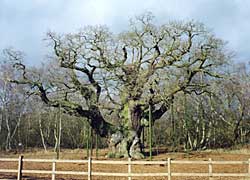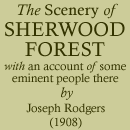< Previous | Contents | Next >
THE MAJOR OAK, OR, THE QUEEN OAK
"But thou, while Kingdoms overset,
Or lapse from hand to hand,
Thy leaf shall never fail, nor yet
Thine acorn in the land."TENNYSON.

The Major Oak, Birklands
WHAT memories of happy hours spent in its leafy shade does the name of this tree bring to thousands! Old men in distant cities tell with what pleasure in their youthful days they climbed the Major's great branches, or hid themselves within his hollow trunk; and that when years had sped away and their climbing days were over, these excursions were still remembered as the happiest of the year; and no journey to the forest could ever be made without a call upon the Major, where, reclining on his ancient roots in company with life-long friends, time passed too quickly away. No merely local fame is his, for year by year men come in greater numbers, and from the most distant regions of the world, to gaze upon his patriarchal form. During his long existence what a circle of acquaintance he might claim, for there is little doubt that the lives of two such trees, one planted at the death of the other, would extend from the commencement of the Christian era to the present day! Perhaps the "lion-hearted Richard" when passing through Sherwood Forest, saw and admired the fair proportions of this oak, for it would then be something like two hundred years old, and just in its youthful prime. Whether the treacherous John put a brand upon it (as on other forest oaks, which the trees made haste to hide away) one cannot tell; but, being so near to the Kings' house at Clipston, it would be known to most of the Plantagenet Kings, and since they vanished from the earth what numbers of other great ones have looked upon his kingly form! And still the tree is full of life, though centuries have passed.
Major Rooke, a noted antiquary who resided in the neighbourhood a hundred and twenty years ago, took a great interest in Sherwood. He discovered the brand of King John, about eighteen inches beneath the bark of one of these oaks, and upwards of a foot from the centre. He also found those of King James, and William and Mary. But this oak was known to be a particular favourite of the Major's, and on that account would be popularly known as the Major's Oak, from which the transition would naturally follow.1
Some of the inhabitants of Edwinstowe living about thirty years ago also remembered the oak by another name—"the Cockpen tree." At one time the neighbourhood was famous for the breed of game cocks, and the Major's hollow trunk was their roosting place.
Christopher Thomson made some measurements of the oak. In his description he says, "Look well at his broad and age-furrowed flanks; see his antique roots thrown firmly into the soil, and observe, that by actual measurement, his bole grips the earth with a circumference of ninety feet; a little higher up, six feet from the ground, his girth is thirty feet; and, of his fifty arms which he throws so majestically around, one alone is twelve feet in circumference, while, unitedly, he waves his oaken wreath over a diameter of two hundred and forty feet! Like the rest of his greenwood brethren, the storms of a thousand winters have shaven his locks and shortened his manly proportions, but they have only scathed—they have not killed him; . . . On one occasion, seven of our villagers took breakfast within the age-scooped trunk of this old oak, and had plenty of room for all the necessary furniture of coffee, kettles, and cups. On many occasions our village choir have stepped aside in their woodland rambles and sheltered themselves within the Major's heart to the number of twelve, and sometimes more.'2
Some years before the production of The Foresters, Lord Tennyson, in company with his son, Mr. Hallam Tennyson, paid a visit to Sherwood Forest. The scene of the play is laid in Sherwood, and Tennyson must have had the Major Oak in mind when writing this passage :
| "Robin Hood. | Where lies that cask of wine whereof we plundered |
| The Norman Prelate ? | |
| Little John. | In that Oak where twelve |
| Can stand inside nor touch each other." |

The Major Oak in 2003.
Excursionists to Sherwood make it their duty to see the Major Oak, and that is generally the extent of their knowledge of the forest. On fine days in summer they resort there in great numbers, and it is seldom they add picturesqueness to the scene. An incident of a pleasing character, however, happened one midsummer evening thirteen years ago through the presence of a party of pleasure-seekers. Though the sun was hidden from sight, he had not yet set; but through an opening among the trees was throwing his last bright golden rays on the Major and the tops of the surrounding oaks. The notes of the cuckoo could still be heard in the direction of the Hall wood ; no other sound was audible, except a blackbird piping in low tones, as though he too would soon be at rest. A flock of swans with outstretched necks was flying high up in the air, in the direction of Rufford Lake. All about the great tree was silent and peaceful, for excursionists had long since left the village. Even the old man, who in summer time has charge of the oak, had gone home hours ago. But now a number of people (perhaps thirty to forty) were seen making their way along the road to the Major Oak. As they drew nearer, it became evident, from their remarks and orderly conduct, that they were not of the class of visitors who come merely for rough enjoyment. The women, who all appeared to be young, were well though plainly dressed. For a short time they wandered about, contemplating the size of the tree, and estimating the capacity of its hollow trunk. They then seated themselves on the great roots and on the ground under the branches; and after conversing a while, one of the party, opening a book, commenced to read aloud, the whole company grouped around. This continued for some time, and wondering what could be of sufficient interest to keep the attention of these people, I heard these lines:
. . . "Me, goddess, bring To
arched walks of twilight groves, And
shadows brown, that Sylvan loves, Of pine,
or monumental oak, Where the rude axe,
with heaved stroke, Was never heard the
nymphs to daunt, Or fright them from their
hallow'd haunt."
These were evidently no ordinary excursionists, or they would not listen to poetry—even Milton's—on such an occasion. After a while, turning to another part of the volume, the reader resumed:
"Haste thee, nymph, and bring with thee
Jest, and youthful Jollity, Quips, and cranks,
and wanton wiles, Nods, and becks, and
wreathed smiles, Such as hang on Hebe's
cheek, And love to live in dimple sleek;
Sport that wrinkled Care derides, And
Laughter holding both his sides. Come, and
trip it, as you go, On the light fantastic
toe."
Owing to the rapidly failing light, the reading ceased ere long. The sky overhead had by this time become of deepest sombre blue, passing by gradations to golden yellow at the horizon, where it was barred by bands of bright crimson, throwing a deep rich glow on all around. Some further time was spent in conversation, when, at a signal from one of the party, the whole number rose to their feet, and forming into two columns—the men on one side and the women on the other—began a slow rhythmic movement to the low music of their own voices, winding about in graceful curves through the wide open space; now the two columns uniting, now dividing, and again uniting; all the while to the low chanting of the dancers. This was continued for some time, the surrounding landscape in the subdued light forming a lovely background to the picture.
The whole incident seemed like a dream, so beautiful, and so different to the ordinary life of to-day. Perhaps it was no less impressive from being entirely unexpected. But this pleasing episode came to an end; the visitors took their way quietly, as they had come, and all was again silent near the great tree.
< Previous | Contents | Next >
1 In answer to an inquiry on this subject addressed some years ago to Lord Hawkesbury (afterwards Earl of Liverpool), who for many years resided at Cockglade, and was an undoubted authority on everything connected with Sherwood, his lordship replied: "I think the name 'Queen Oak' is older than you imagine. It was certainly so called in the late Lord Manver's time, and I have always known it under that name from my earliest childhood, when we went over often from Osberton to picnic there, between forty and fifty years ago. And my father (born 1800) always called it by that name." There is an early water-colour drawing at Osberton of the last century of the tree, and I think it is marked at the back in writing of the date: "The Queen Oak, in Birkland."
2 Autobiography of an Artisan.
